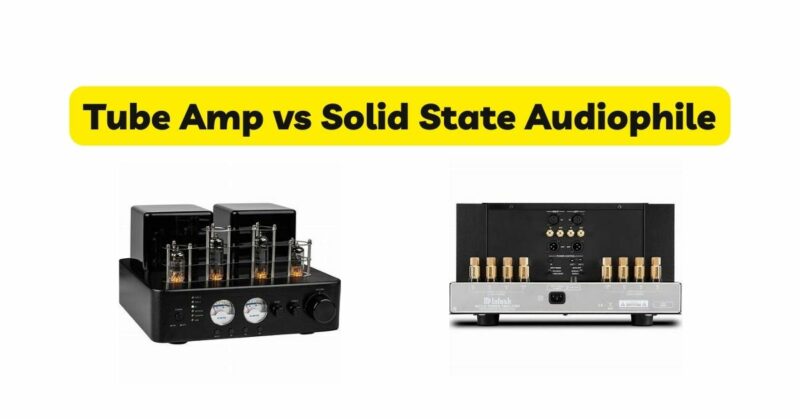For passionate audiophiles, the choice between a tube amplifier and a solid-state amplifier is a subject of much debate. Both technologies have their devoted followers, each arguing for the superiority of their preferred option. In this article, we will delve into the tube amp vs. solid state dilemma, examining the sonic characteristics, advantages, and drawbacks of each technology to help audiophiles make an informed decision based on their preferences and listening requirements.
Part 1: Sonic Characteristics
Tube amplifiers, known for their warm and rich sound, have long been revered for their ability to produce a natural and pleasing sonic experience. Tube technology introduces harmonic distortion and subtle tonal variations that many listeners find pleasing and musical. Tubes are often associated with a smooth and organic sound, with a touch of “warmth” that enhances the overall listening experience. They excel at reproducing vocals, acoustic instruments, and genres such as jazz and classical music.
On the other hand, solid-state amplifiers are lauded for their accuracy and precision. They deliver a more transparent and neutral sound reproduction, striving for a faithful representation of the source material. Solid-state amplifiers offer excellent transient response, tight bass control, and high power output capabilities. They are favored by listeners who prioritize accuracy, detail retrieval, and an analytical listening experience. Solid-state amplifiers are well-suited for genres such as rock, electronic music, and genres that demand precise and tight bass reproduction.
Part 2: Advantages and Drawbacks
Tube Amplifiers: Tube amplifiers have several advantages that appeal to audiophiles. Their harmonic distortion can impart a pleasing and euphonic character to the sound, enhancing the perceived depth and musicality of the music. Tubes often exhibit a forgiving nature, smoothing out harsh recordings and providing a more forgiving listening experience. Additionally, tube amplifiers tend to have a more forgiving speaker load, allowing them to pair well with a broader range of speakers.
However, tube amplifiers also have some drawbacks. They are generally more expensive to manufacture, and their tube components require periodic replacement, which can add to the cost of ownership. Tubes can be delicate and susceptible to damage, and they generate heat, requiring proper ventilation and care. Tube amplifiers also tend to be heavier and less efficient in terms of power consumption.
Solid-State Amplifiers: Solid-state amplifiers offer several advantages that make them popular among audiophiles. They typically have a lower cost of ownership since they do not require tube replacements. Solid-state amplifiers are generally more reliable, durable, and less prone to damage from transportation or mishandling. They often have a higher power output, enabling them to drive demanding speakers with ease. Solid-state amplifiers are also more energy-efficient and generate less heat than tube amplifiers.
However, solid-state amplifiers are not without their drawbacks. Some audiophiles find the sound produced by solid-state amplifiers to be less “musical” or “engaging” compared to tube amplifiers. The solid-state sound can be perceived as more clinical or analytical, lacking the subtle harmonic distortion and warmth associated with tubes. Additionally, solid-state amplifiers may not pair well with certain speakers, especially those that require a more forgiving load.
Part 3: Personal Preference and Listening Experience
The choice between a tube amp and a solid-state amp ultimately comes down to personal preference and the desired listening experience. Both technologies offer distinct sonic signatures and cater to different musical tastes and listening habits.
Audiophiles who prioritize a warm and euphonic sound, with a focus on vocal and instrumental reproduction, may gravitate towards tube amplifiers. They appreciate the harmonic distortion, tonal colorations, and the musicality that tubes bring to the listening experience. Tube amplifiers can be an excellent choice for those who primarily listen to jazz, classical, or acoustic music, where the emphasis is on the organic and natural qualities of the sound.
On the other hand, audiophiles who value accuracy, detail retrieval, and precise sound reproduction may prefer solid-state amplifiers. They appreciate the transparency, analytical nature, and ability to reproduce complex passages with precision. Solid-state amplifiers are well-suited for genres that demand tight bass control, impactful dynamics, and high power output, such as rock or electronic music.
Conclusion : The tube amp vs. solid-state debate has been ongoing in the audiophile community for decades, and there is no definitive answer to which is better. Both technologies have their strengths and weaknesses, appealing to different listeners and musical preferences. Ultimately, the choice between a tube amplifier and a solid-state amplifier should be based on personal preference, listening habits, and the desired sonic characteristics. Audiophiles should audition both types of amplifiers with their preferred music and speakers to determine which one aligns best with their tastes and provides the most enjoyable listening experience. Remember, the pursuit of audio nirvana is highly subjective, and there is no one-size-fits-all solution.


